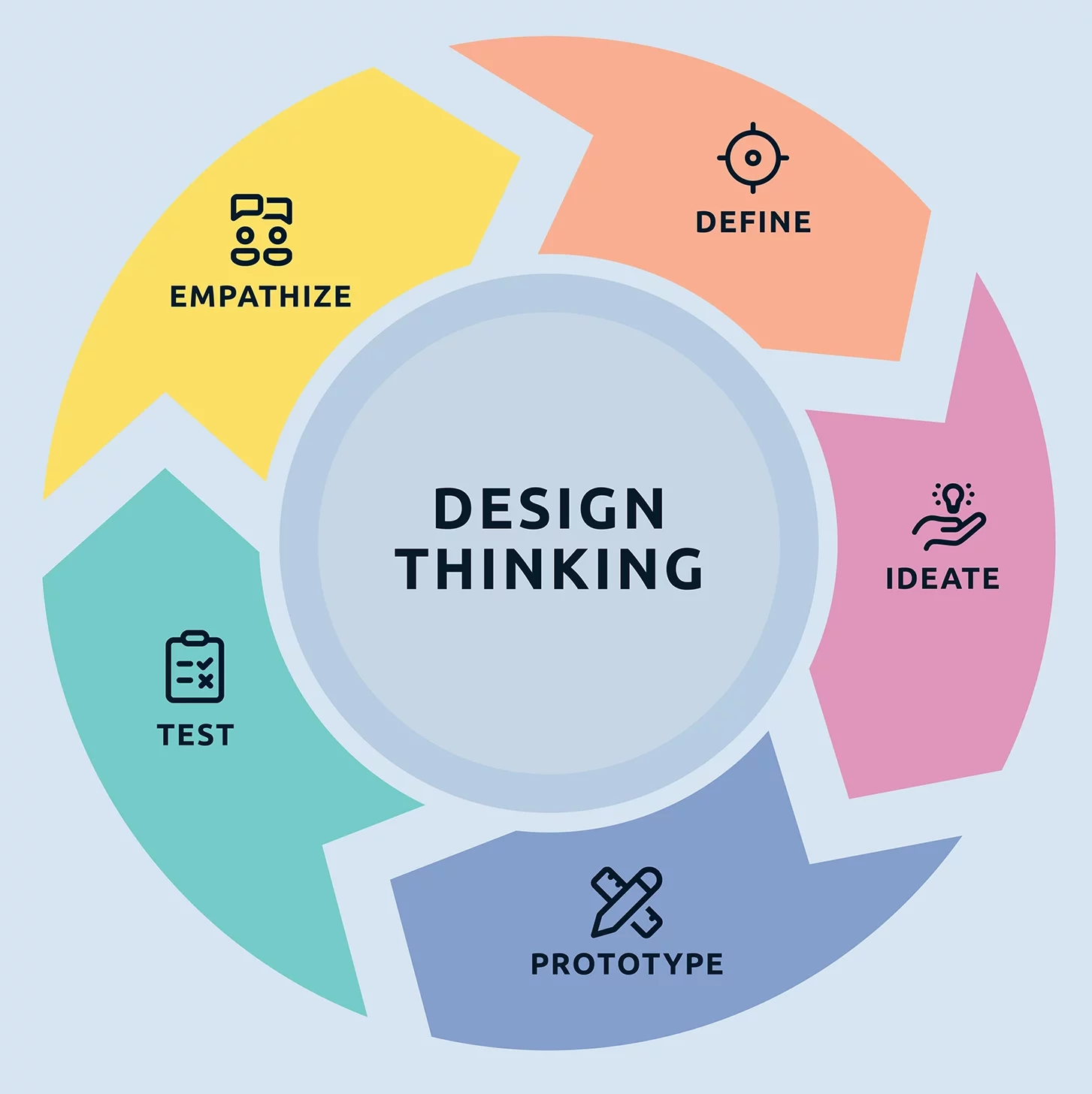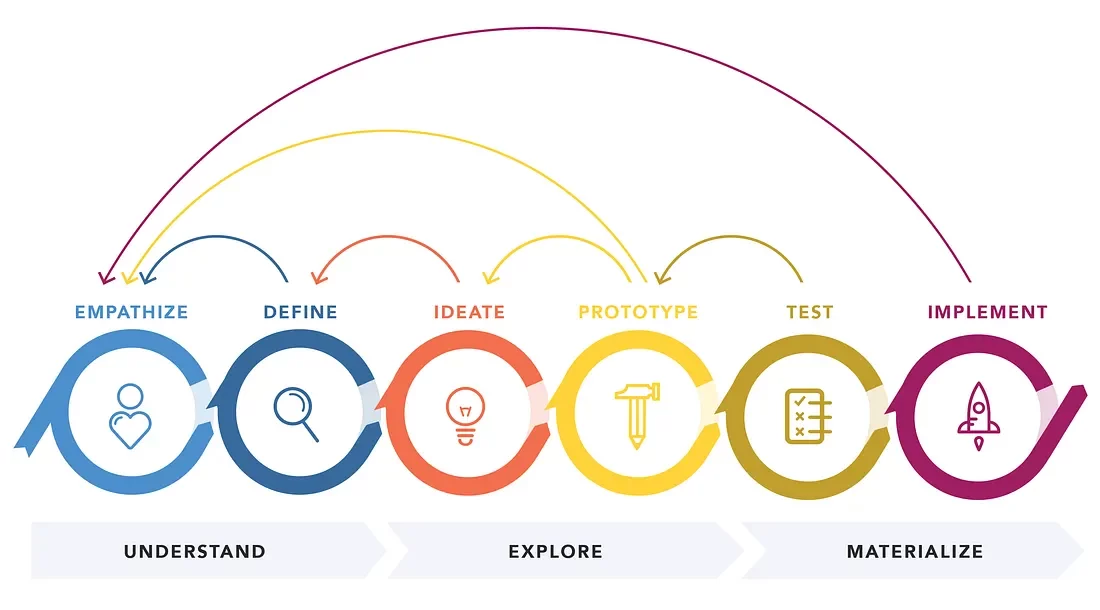Design Thinking: Core of Testing & Iteration
Table of Contents

When it comes to business, the space is highly evolving, and with changing demand, what brought success yesterday may not work tomorrow. Which means that if you are a professional or entrepreneur aiming for business excellence, the ability to adapt, innovate, and reimagine solutions is a necessity.
This is where design thinking proves invaluable. By blending empathy, creativity, and rigorous testing, it equips leaders and entrepreneurs to move beyond surface-level assumptions and design solutions that truly resonate with people.
In this blog, we’ll dive into the core meaning of this concept, the step-by-step process behind it, and why testing and iteration are essential to achieving business excellence.
What is Design Thinking and Why It Matters

*digitalleadership.com
The easiest way to describe design thinking is solving problems the way that people actually experience them, not the way we think they do.
Rather than trusting spreadsheets, market trends, or boardroom assumptions, it forces you to listen closer to your customers, employees, or partners. It’s empathy before ideas and then solutions that actually work, rather than simply appearing convincing on paper.
For companies, this change is compelling. It translates into fewer expensive mistakes, more loyal customers, and the capacity to innovate through periods of uncertainty. If you’re planning for business greatness, you can’t afford to overlook it.
How the Design Thinking Process Works

*medium.com
Now that we’ve touched on the meaning, let’s break down how it actually works in practice.
At its core, the design intelligence process follows five steps. Don’t think of them as a rigid checklist, though, it’s more like a loop you can revisit as often as needed.
Step 1: Empathize
This is where everything begins. You dive into your users’ world, not to sell them something, but to understand them deeply.
Imagine you’re running a financial services firm. Instead of assuming clients want “more digital tools,” you spend time interviewing them. What you discover is eye-opening: clients don’t just want online dashboards, they want reassurance. They want financial advice that feels human, not robotic. Without empathy, you’d have missed this completely.
Step 2: Define
Once you’ve gathered insights, you shape them into a problem worth solving. Not the one like, “We need to improve our app,” but something focused, like, “How might we create a mobile experience that reduces anxiety around investment decisions?”
This reframing changes everything. You’re no longer chasing a broad target, instead, you’re aiming at a clear, solvable issue.
Step 3: Ideate
Brainstorming without judgment happens here. From practical fixes to bold experiments, the aim is to push boundaries. Often, the most unusual idea sparks breakthroughs.
Pro Tip: Encourage diverse teams to ideate together. A finance professional, a designer, and a sales manager will approach the same problem from different angles, and that’s where innovation thrives.
Step 4: Prototype
Instead of lengthy business cases, prototypes help teams “show, not tell.” They can be mock-ups, demos, or role-playing exercises. The goal isn’t perfection, it’s speed.
This step turns abstract ideas into something stakeholders and users can interact with.
Step 5: Test
Testing is where ideas meet reality. Feedback from real users guides refinement, often sending teams back to earlier stages. Far from being a setback, this looping back is the core strength of the design thinking process.
Why Testing and Iteration are the Heart of Design Thinking
Here’s a truth every entrepreneur and professional should remember: no solution is perfect the first time. The strength of the design thinking process lies in its embrace of iteration.
When you build, test, refine, and repeat, you reduce risks dramatically. You also create a culture where teams see feedback as fuel, not criticism.
Let’s contrast two scenarios:
- A retail chain invests millions in redesigning its stores based on internal assumptions. Customers walk in, feel overwhelmed, and sales dip.
- Another chain uses design thinking. They prototype new layouts in one small location, invite real shoppers, gather feedback, and adjust. When they finally expand, they know the design works.
Same goal but completely different outcomes.
Real-World Proof: Companies Thriving with Design Thinking
It’s one thing to talk theory, but let’s look at businesses that used design thinking to move the needle.
- Airbnb: Early on, they struggled to attract guests. Instead of pouring more money into ads, the founders sat with hosts, studied their listings, and noticed one thing, which was mostly poor photos. By simply taking high-quality images themselves, bookings grew exponentially. Empathy, not marketing, was the turning point.
- Apple: The iPod wasn’t revolutionary because it stored music. It was revolutionary because it made music effortless. Apple understood that people didn’t just want capacity, they wanted joy and simplicity in the experience.
- Healthcare: A children’s hospital in the U.S. used design thinking to transform intimidating MRI scans into adventures. By turning the machines into “spaceships” with painted walls and themed experiences, patient anxiety dropped significantly.
Notice how each example starts with people, not products.
The Business Value of Design Thinking Beyond Creativity
For some leaders, design thinking sounds “too creative” or “soft.” But here’s the reality: it delivers measurable business impact.
- A study by Forrester found that 71% of organizations using design thinking launched products faster.
- IBM integrated design thinking across its teams and reported a 300% increase in efficiency.
- Startups applying this approach raise higher funding because investors trust their user-validated models.
This isn’t about art. It’s about strategy, efficiency, and long-term profitability.
Traditional Strategy vs. Design Thinking
To really see the difference, compare the old and new ways of problem-solving:
| Traditional Approach | Design Thinking Approach |
| Linear process | Iterative cycle |
| Focus on business goals | Focus on human needs |
| Feedback after launch | Feedback throughout |
| Risk of expensive mistakes | Early corrections save costs |
In other words, while traditional strategy asks, “What should we build?”, design thinking asks, “What do people truly need, and how do we keep improving it?”
Why Professionals and Entrepreneurs Should Pay Attention
If you’re a professional aiming for leadership or an entrepreneur trying to disrupt your industry, mastering design thinking steps gives you a real edge. It helps you:
- Navigate uncertainty with confidence.
- Unlock hidden opportunities by reframing problems.
- Align cross-functional teams with a shared vision.
- Build solutions that not only succeed in the market but also last.
And perhaps most importantly, it builds resilience. Because in a world where change is constant, resilience comes not from sticking to one big plan, but from adapting, testing, and evolving with speed.
How Jaro Education Can Help You Master Design Thinking
Understanding the design thinking process and mastering it to drive real business transformation is two different things. This is where structured learning can make all the difference. At Jaro Education, we partner with leading institutions to bring you cutting-edge programs designed for professionals who want to stay ahead.
One such program is the Certificate Programme in Design Thinking & Innovation for Business Excellence by IIM Indore. Over 10 months, you’ll explore the steps, from empathy and ideation to prototyping and testing, while applying them to real business challenges. The program blends live online classes with a campus immersion, case studies, and projects, ensuring you don’t just learn the design thinking meaning but actually practice it in action.
If you’re a leader, entrepreneur, or professional aiming to unlock innovation and business excellence, this program offers the tools, mentorship, and alumni network to help you make that leap.
Conclusion
In today’s dynamic business world, change is the only constant. For professionals and entrepreneurs, this means that relying solely on past strategies is no longer enough. Design thinking provides a structured yet flexible path forward, one that blends empathy, creativity, and iteration to solve problems that truly matter.
By applying the design thinking process, you can uncover hidden customer needs, innovate with clarity, and test ideas before scaling them, minimizing risk and maximizing impact. From startups to global enterprises, the organizations that thrive are those that treat design thinking not as a buzzword but as a way of driving business excellence.
At Jaro Education, we believe that the future belongs to leaders who can think differently. Our Certificate Programme in Design Thinking & Innovation for Business Excellence by IIM Indore is designed to help professionals like you embrace innovation and turn challenges into opportunities. By mastering design thinking steps, you’ll not only adapt to change, you’ll lead it.
Business excellence is no longer a distant goal; with the right mindset and the right learning, it’s within reach.
Frequently Asked Questions
What is design thinking in simple terms?
It’s a problem-solving approach that focuses on understanding people, brainstorming ideas, testing, and refining solutions.
Why is design thinking important for businesses?
It helps businesses create solutions that are innovative, customer-focused, and practical for real-world needs.
What are the key design thinking steps?
Empathize, Define, Ideate, Prototype, and Test, applied in a cycle of learning and iteration.
Can entrepreneurs use design thinking?
Absolutely, startups use it to validate ideas quickly, reduce risks, and create user-centric products.
How can I learn design thinking professionally?
Through structured programs like Jaro Education’s IIM Indore Certificate in Design Thinking & Innovation, which blends theory with hands-on projects.






![Salary-of-BCA-Graduates-Top-Job-Roles-[2025]](https://jaro-website.s3.ap-south-1.amazonaws.com/2025/10/Salary-of-BCA-Graduates-Top-Job-Roles-2025-1024x576.webp)










